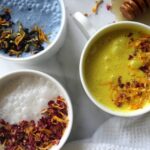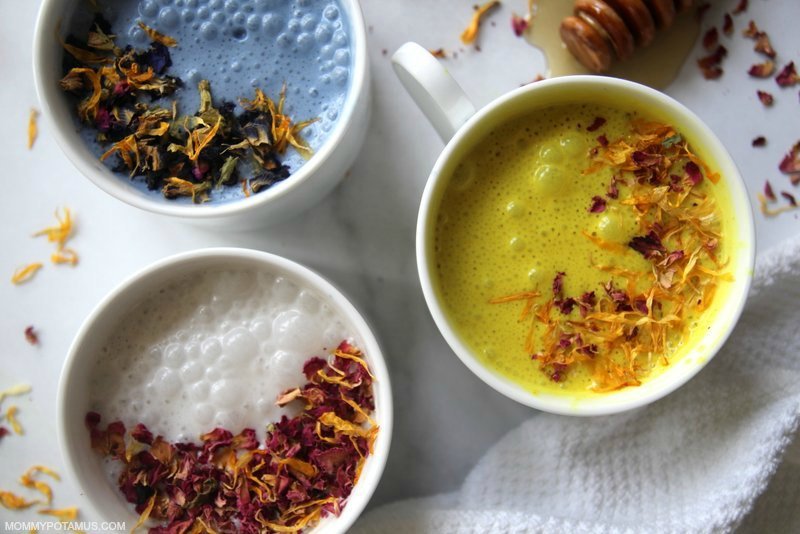
If you’ve never replied “I. AM. ALCHEMIST.” to a text question about the grocery ingredients you requested, get ready. These relaxing moon milk recipes are full of familiar, comforting flavors blended together with a few out-of-the-ordinary twists.
You might have noticed from my library that I’m very much a research nerd, with titles like Adaptogens In Medical Herbalism and The Modern Herbal Dispensatory: A Medicine-Making Guide.
That wisdom is contained in these recipes, but in addition there’s also something that just feels so beautiful and therapeutic – even enchanting – about whipping up a nighttime cup of moon milk.
Infused with ashwagandha root – which supports resilience during times of chronic stress and can help rebuild when we’ve already overdone things – these recipes are perfect for unwinding after a long day. I like to sip mine while curled up with my weighted blanket, or out on my patio underneath the stars. But I’m getting ahead of myself, because you’re probably wondering . . . .
What is moon milk? ^
In Ayurveda – which translates from Sanskrit as “The Science of Life” and is one of the oldest systems of healing in the world – warm milk has long been used to ease occasional sleeplessness. Moon milk, which has a few basic components we’ll cover below, is based on this traditional use.
Interestingly, when cows are milked at night, their milk contains higher levels of two compounds that help with rest and relaxation: tryptophan and melatonin. (1)
If you’re dairy-free, this recipe is for you, too! Some nut milks contain naturally occurring tryptophan and melatonin, too, which I’ll cover in more detail below.
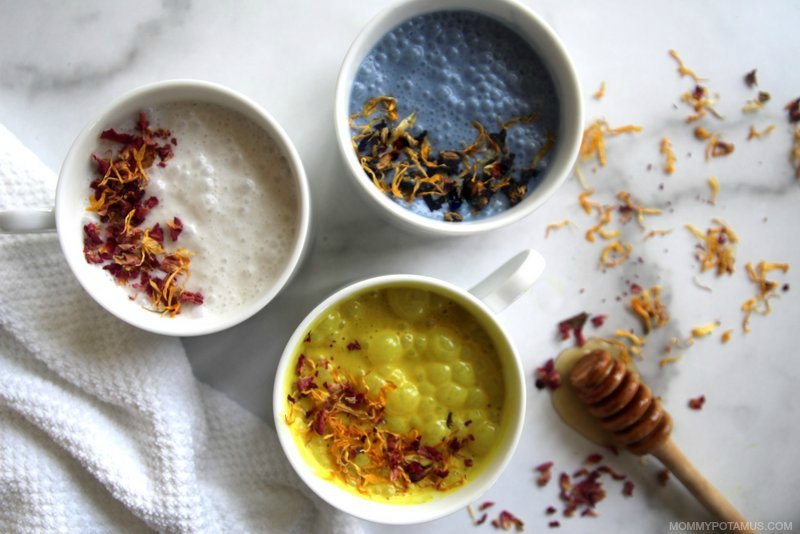
What are the ingredients in moon milk? ^
Moon milk can be a simple preparation of milk and honey, or a rich infusion of calming herbs and warming spices with a touch of sweetener. I prefer to add herb and spices to add flavor while also calming the nervous system and helping the body to prepare for sleep. Here’s an overview of the most common ingredients.
Milk
This is of course the creamy base – without it I suppose this drink would be moon juice which doesn’t have quite the same ring. As mentioned above, cow’s milk contains naturally occurring compounds like tryptophan and melatonin which have a relaxing effect. Some nut milks do, too. For example:
- Almond milk contains melatonin, tryptophan and the “magic mineral,” magnesium (2)
- Raw oats are a rich source of tryptophan and magnesium, and also contain some melatonin. Since oat milk is made from raw oats, it is too. (3)
- Homemade cashew milk and coconut milk (both homemade and store-bought) are rich in magnesium and have a lovely, creamy texture that works beautifully for making moon milk.
Speaking of texture, if the milk you’re using is on the thinner side, you can add a little unrefined coconut oil or ghee to add a touch of creaminess. I’ve included suggestions for amounts below.
Therapeutic Herbs & Warming Spices
Although there are a lot of herbs that support restful sleep, many have a distinctive flavor that doesn’t necessarily work well in a creamy dreamland drink (I’m looking at you, valerian.)
Fortunately, there are a lot that work beautifully, including:
Featured Herb: Ashwagandha
Ashwagandha is one of the most popular herbs to use in moon milk due to its optimization of the GABA neurotransmitter pathway. GABA is one of the main sedative neurotransmitters. Its associated with improved mood, a sense of calm and tranquility, deep sleep, help with PMS, and calm focus. (4)
Maybe that’s why its Latin species name, somnifera, literally translates as “sleep inducing.”
Ashwagandha is also considered an adaptogen – or herb that helps the body adapt to stress – and has long been used to help fortify resilience during times of chronic stress.
But ashwagandha doesn’t just help us stay strong for longer . . . it can help rebuild when we’ve already overdone things. That’s why Ayurveda classifies ashwagandha as a rasayana, or “herb that deeply rejuvenates and promotes longevity.” (4) If you want to dive deeper into the benefits of ashwagandha, which is best used over a period of time for maximum effect, hop over to this article.
Other sleep supporting herbs:
- Catnip– This herb is what herbalists call a “relaxing nervine”, which means that it helps create a sense of peace, calms overstimulation, and eases forehead tension and motion sickness.
- Chamomile – “For years I was wrong about chamomile,” writes herbalist Rosalee de la Foret, “I thought of it as gentle and therefore, weak. I thought that because it was safe enough for little ones (like Peter Rabbit), it wasn’t effective for the more serious problems of adults. But that is the beautiful secret of chamomile. As beloved herbalist Rosemary Gladstar so wisely says, ‘Chamomile demonstrates to us that gentle does not mean less effective.” (5)
- Butterfly Pea Flower – According to a study in the Journal of Ethnopharmacology, this herb has been used for centuries to ease feelings of restlessness, prepare for deep sleep, unwind from stress, lift mental outlook, support memory function, and more. (6) In Southeast Asia, it’s often sipped before bedtime (like other regions drink chamomile tea) to promote relaxation. It’s beautiful hue is what gives the Blue Moon Milk recipe below its color.
As you’ll see in the recipes, I call for steeping herbal leaves and flowers for 5-10 minutes in hot water, but add herbal roots in powdered form. That’s because roots have to be simmered for longer to draw out their therapeutic properties, so in order to keep the process short I add them whole.
Warming Spices
Spices like turmeric, cinnamon, nutmeg, ginger, and cardamom do double duty in the Golden Milk and Caffeine-Free Chai recipes below. They have a warming quality that helps to relax the nervous system and many have other therapeutic properties that make them well-suited for bedtime.
Ginger and turmeric, for example, also have adaptogenic properties that support our bodies management of stress. The main bioactive compound in turmeric, curcumin, is best absorbed by the body when taken with black pepper and some kind of fat. Black pepper contains piperine, which can increase the absorption of curcumin by up to 2,000%. (7)
Sweetener of Choice
Wholesome sweeteners such as maple syrup, raw honey, or pure monk fruit extract all work well in the recipes below.
How To Make Moon Milk ^
Although the ingredients will vary based on the flavor you choose, here’s the basic technique:
1. Add milk, herbs and spices to a small saucepan.
2. Heat to a low simmer, then remove the pan from heat. Cover with a lid and allow to steep for 5-10 minutes.
3. Once the moon milk is done steeping, remove the tea bag or strain the liquid into a mug.
4. Add sweetener to taste. Sip and – if desired – stir in a teaspoon or two of ghee or coconut oil for additional creaminess.
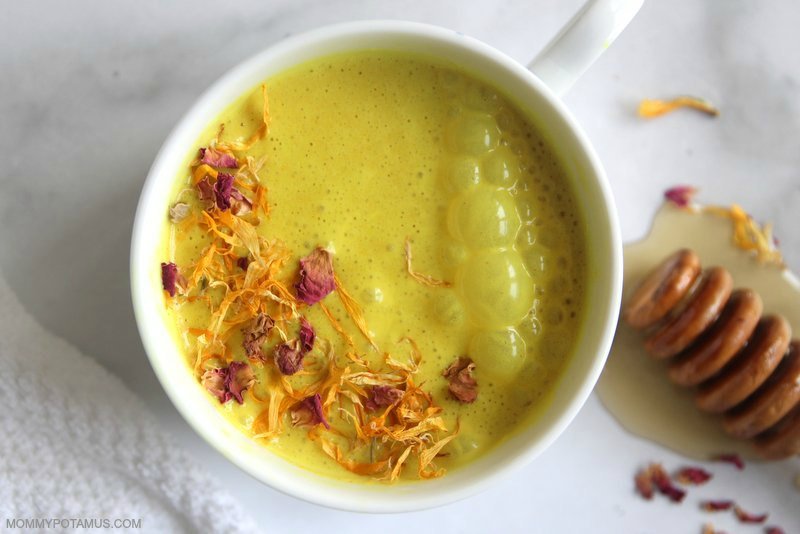
Golden Moon Milk Recipe With Turmeric ^
This is basically golden milk with a few additional relaxing herbs added. It’s deeply nourishing and warming.
Ingredients
- 1 1/4 cups milk of choice (cow’s milk, almond, coconut, cashew, oat)
- 3/4 teaspoon ground turmeric
- 1/4 teaspoon ashwagandha powder
- 1/8 teaspoon ground ginger
- 1/8 teaspoon ground cinnamon
- Pinch of black pepper
- Sweetener of choice to taste (maple syrup, raw honey, or pure monk fruit extract)
- 1 chamomile tea bag or 1 teaspoon loose herb (optional)
- 1-2 teaspoons ghee or coconut oil (optional)
- Organic flower petals for garnish (optional)
Instructions
1. Add milk to a small saucepan. Sprinkle turmeric, ashwagandha powder, ginger, cinnamon and black pepper somewhat evenly over the surface. It doesn’t have to be perfect, it just helps prevent clumping when you whisk. Add loose chamomile tea (if using) and whisk until well combined. If you’re using a chamomile tea bag, add it to the pot after you’ve whisked everything else together.
2. Heat pan to a simmer. As soon as it starts simmering, remove it from heat and cover the pan with a lid. Allow to steep for 5-10 minutes.
3. Once the moon milk is done steeping, remove the tea bag or strain the liquid into a mug. I love this type of stainless steel tea strainer that allows you to pour everything into your cup and then just lift out the loose herbs.
4. Add sweetener to taste. Sip and – if desired – stir in a teaspoon or two of ghee or coconut oil for additional creaminess.
Optional step: Froth with a milk frother and/or garnish with organic, food-grade calendula or rose petals if desired.
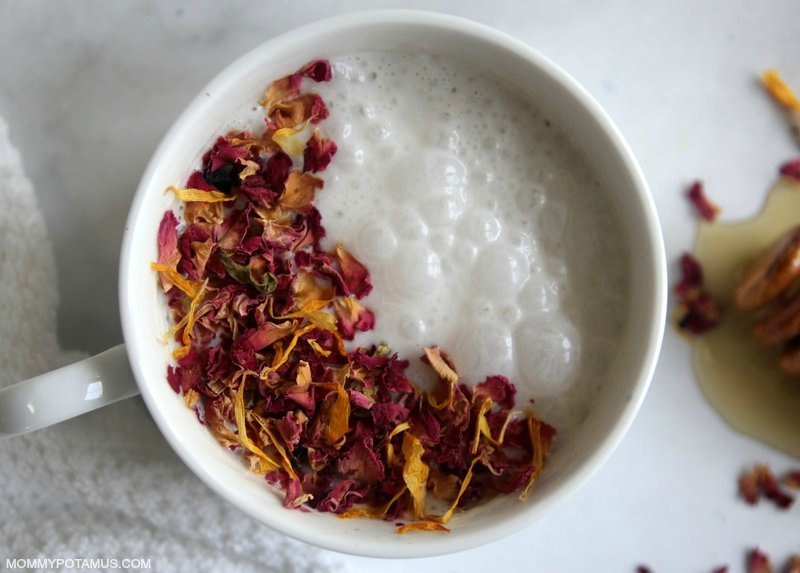
Goodnight Moon Milk ^
This is my basic moon milk recipe. It’s simple, creamy, delicious, and can easily be adapted to your favorite flavors. I sometimes use almond extract instead of vanilla and it’s delicious.
Ingredients
- 1 1/4 cups milk of choice (cow’s milk, almond, coconut, cashew, oat)
- 1/4 teaspoon ashwagandha powder
- 1 bag of chamomile or catnip tea (or 1 teaspoon loose herb)
- 1/2 teaspoon vanilla extract
- Sweetener of choice to taste (maple syrup, raw honey, or pure monk fruit extract)
- 1-2 teaspoons ghee or coconut oil (optional)
- Organic flower petals for garnish (optional)
Instructions
1. Add milk to a small saucepan. Sprinkle ashwagandha powder somewhat evenly over the surface (this helps prevent clumping when you whisk). Add vanilla and loose herbs (if using) and whisk until well combined. If you’re using a tea bag, add it to the pot after you’ve whisked everything else together.
2. Heat pan to a simmer. As soon as it starts simmering, remove it from heat and cover the pan with a lid. Allow to steep for 5-10 minutes.
3. Once the moon milk is done steeping, remove the tea bag or strain the liquid into a mug. I love this type of stainless steel tea strainer that allows you to pour everything into your cup and then just lift out the loose herbs.
4. Add sweetener to taste. Sip and – if desired – stir in a teaspoon or two of ghee or coconut oil for additional creaminess.
Optional step: Froth with a milk frother and/or garnish with organic, food-grade calendula or rose petals if desired.
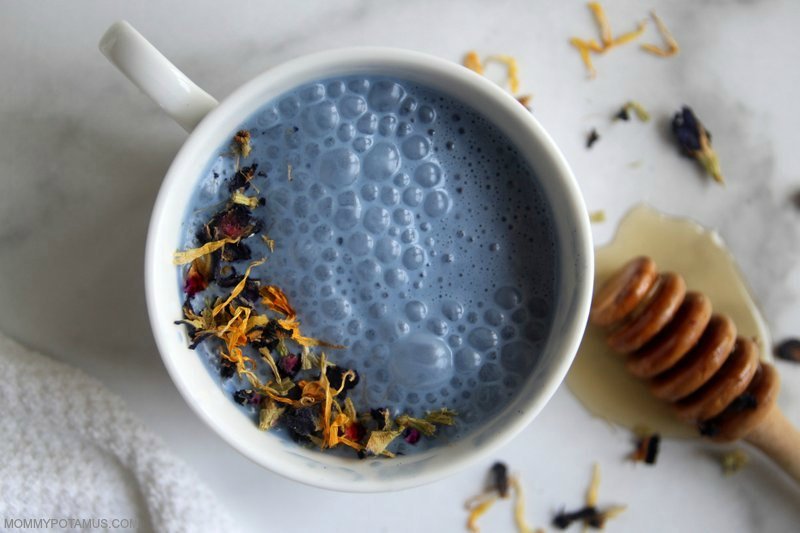
Blue Moon Milk Recipe ^
Ingredients
- 1 1/4 cups milk of choice (cow’s milk, almond, coconut, cashew, oat)
- 1/4 teaspoon ashwagandha powder
- 3 tablespoons dried butterfly pea flower tea (loose herb)
- 1/2 teaspoon vanilla extract
- Sweetener of choice to taste (maple syrup, raw honey, or pure monk fruit extract)
- 1-2 teaspoons ghee or coconut oil (optional)
- Organic flower petals for garnish (optional)
Instructions
1. Add milk to a small saucepan. Sprinkle ashwagandha powder somewhat evenly over the surface – it doesn’t need to be perfect, it just helps prevent clumping when you whisk. Whisk until well combined, then add vanilla and butterfly pea flower and stir again.
2. Heat pan to a simmer. As soon as it starts simmering, remove it from heat and cover the pan with a lid. Allow to steep for 5-10 minutes.
3. Once the moon milk is done steeping, strain out the butterfly pea petals. I love this type of stainless steel tea strainer that allows you to pour everything into your cup and then just lift out the loose herbs.
4. Add sweetener to taste. Sip and – if desired – stir in a teaspoon or two of ghee or coconut oil for additional creaminess.
Optional step: Froth with a milk frother and/or garnish with butterfly pea petals, calendula flower, or edible rose petals if desired.
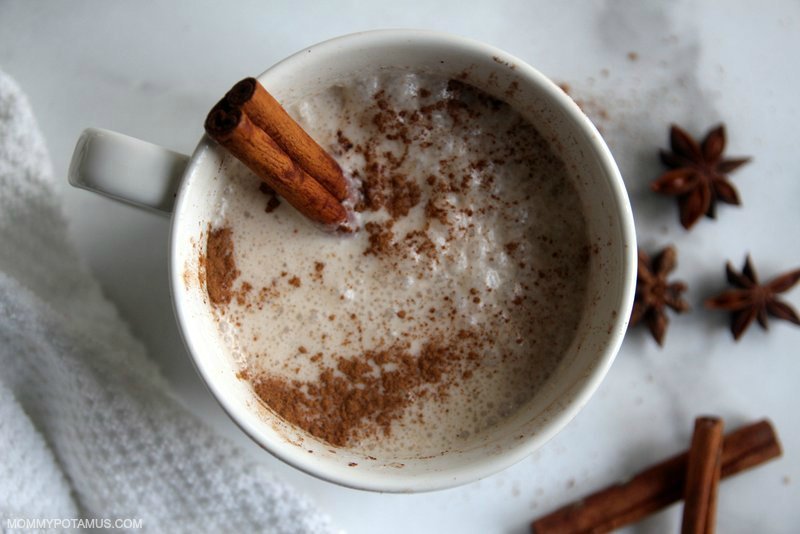
Chai Moon Milk ^
If you have it on hand, you can use 1 3/4 teaspoons homemade chai mix instead of the individual spices below.
Ingredients
- 1 1/4 cups milk of choice (cow’s milk, almond, coconut, cashew, oat)
- 1/2 teaspoon ground ginger
- 1/2 teaspoon ground cinnamon
- 1/4 teaspoon ashwagandha powder
- 1/8 teaspoon ground cardamom
- 1/8 teaspoon ground allspice
- 1/8 teaspoon ground nutmeg
- 1/8 teaspoon ground cloves
- pinch white pepper or black pepper
- 1/4 teaspoon vanilla extract
- 1 bag chamomile tea or 1 teaspoon loose herb (optional)
- 1-2 teaspoons ghee or coconut oil (optional)
- Cinnamon stick or star anise for garnish (optional)
Instructions
1. Add milk to a small saucepan. Sprinkle ground ginger, ashwagandha powder, cinnamon, cardamom, allspice, nutmeg, and ground cloves somewhat evenly over the surface. It doesn’t have to be perfect, it just helps prevent clumping when you whisk.
2. Add vanilla extract and loose chamomile tea (if using) and whisk until well combined. If you’re using a chamomile tea bag, add it to the pot after you’ve whisked everything else together.
3. Heat pan to a simmer. As soon as it starts simmering, remove it from heat and cover the pan with a lid. Allow to steep for 5-10 minutes.
4. Once the moon milk is done steeping, remove the tea bag or strain the liquid into a mug. I love this type of stainless steel tea strainer that allows you to pour everything into your cup and then just lift out the loose herbs.
5. Add sweetener to taste. Sip and – if desired – stir in a teaspoon or two of ghee or coconut oil for additional creaminess.
Optional Step: Optional step: Froth with a milk frother and/or garnish with a cinnamon stick or star anise if desired.
Frequently Asked Questions ^
When should I drink moon milk?
I usually sip mine a couple of hours before I plan to go to bed because I intermittent fast. It helps me unwind and get to bed early. However, there are nights when I stay up later and have a snack while watching a movie with my husband – on those nights I sip it about 30-60 minutes before bed.
Can I use ashwagandha in the day or is it just a nighttime herb?
It can be used during the day. Unlike some herbs, which have exclusively stimulating or sedative properties, ashwagandha works as a rayasana, or “herb that deeply rejuvenates and promotes longevity,” through a variety of therapeutic actions. I often use it to make a daytime ashwagandha latte.
Moon Milk Recipe ^
Equipment
- Milk frother (optional)
Ingredients
- 1¼ cup milk of choice (cow's milk, almond, coconut, cashew, oat)
- ¼ tsp ashwagandha powder
- 1 bag chamomile or catnip tea (or 1 teaspoon loose herb)
- ½ tsp vanilla extract (how to make vanilla extract)
- Sweetener of choice to taste (maple syrup, raw honey, or pure monk fruit extract)
- 1-2 tsp ghee or coconut oil (optional)
- organic flower petals for garnish (optional
Instructions
- Add milk to a small saucepan. Sprinkle ashwagandha powder somewhat evenly over the surface (this helps prevent clumping when you whisk). Add vanilla and loose herbs (if using) and whisk until well combined. If you're using a tea bag, add it to the pot after you've whisked everything else together.
- Heat pan to a simmer. As soon as it starts simmering, remove it from heat and cover the pan with a lid. Allow to steep for 5-10 minutes.
- Once the moon milk is done steeping, remove the tea bag or strain the liquid into a mug. I love this type of stainless steel tea strainer that allows you to pour everything into your cup and then just lift out the loose herbs.
- Add sweetener to taste. Sip and – if desired – stir in a teaspoon or two of ghee or coconut oil for additional creaminess.
- Optional step: Froth with a milk frother and/or garnish with organic, food-grade calendula or rose petals if desired.
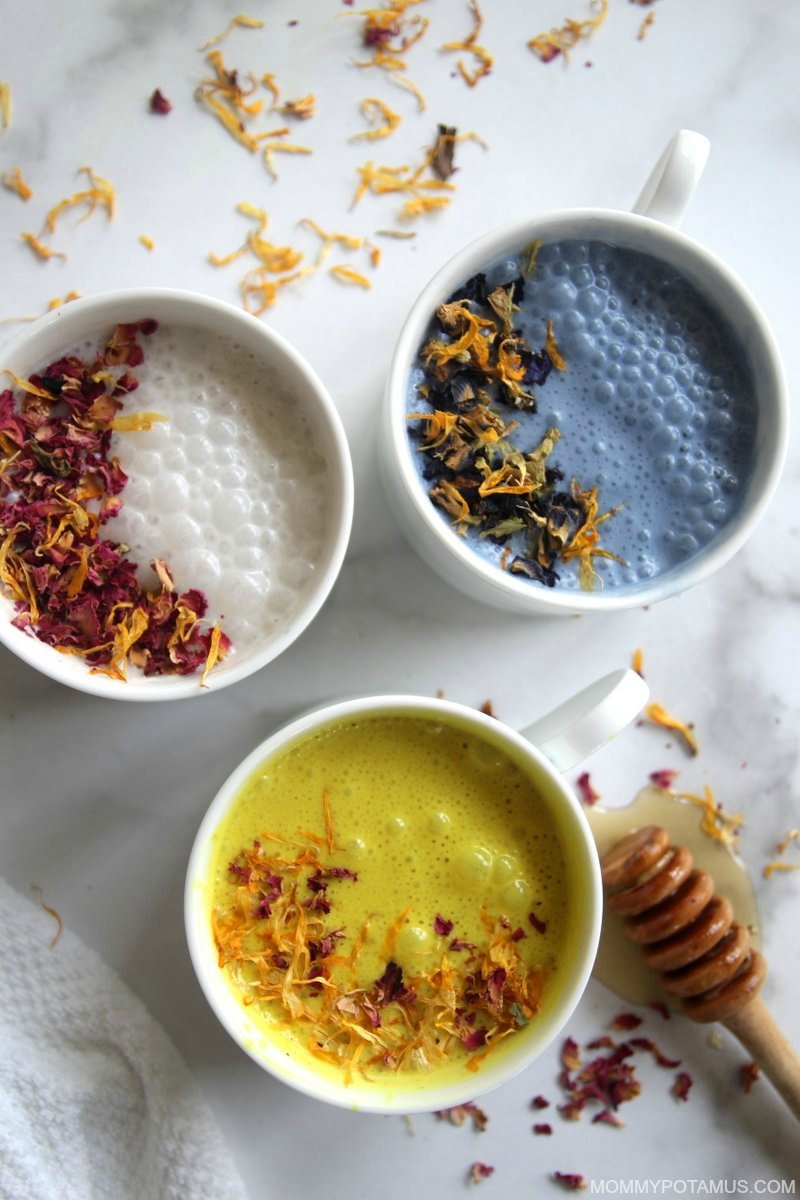
Sources
1. Romanini, Edilson Bruno (2018) Melatonin concentration in cow’s milk and sources of its variation
2. Paroni, Rita (2019) Bioactive phytochemicals of tree nuts. Determination of the melatonin and sphingolipid content in almonds and pistachios
3. Meng, Xiao et. al. (2017) Dietary Sources and Bioactivities of Melatonin
4. Kumar, A. and Kalonia, H. (2008) Effect of Withania somnifera on Sleep-Wake Cycle in Sleep-Disturbed Rats: Possible GABAergic Mechanism
5. de la Foret, Rosalee (2017) Alchemy of Herbs: Transform Everyday Ingredients into Foods and Remedies That Heal
6. Mukherjee, Pulok (2008) The Ayurvedic medicine Clitoria ternatea—From traditional use to scientific assessment
7. Gupta, Subash (2013) Therapeutic Roles of Curcumin: Lessons Learned from Clinical Trials

